Prediction of mortality in patients with colorectal perforation based on routinely available parameters: a retrospective study
- PMID: 26213564
- PMCID: PMC4513392
- DOI: 10.1186/s13017-015-0020-y
Prediction of mortality in patients with colorectal perforation based on routinely available parameters: a retrospective study
Abstract
Introduction: Even after surgery and intensive postoperative management, the mortality rate associated with colorectal perforation is high. Identification of mortality markers using routinely available preoperative parameters is important.
Methods: We enrolled consecutive patients with colorectal perforation who underwent operations from January 2010 to January 2015. We divided them into a mortality and survivor group and compared clinical characteristics between the two groups. Additionally, we compared the mortality rate between different etiologies: malignant versus benign and diverticular versus nondiverticular. We used the χ (2) and Mann-Whitney U tests and a logistic regression model to identify factors associated with mortality.
Results: We enrolled 108 patients, and 52 (48 %) were male. The mean age at surgery was 71 ± 13 years. The postoperative mortality rate was 12 % (13 patients). Multivariate logistic regression analysis showed that a high patient age (odds ratio [OR], 1.09; 95 % confidence interval [CI], 1.020-1.181) and low preoperative systolic blood pressure (OR, 0.98; 95 % CI, 0.953-0.999) were independent risk factors for mortality in patients with colorectal perforation. In the subgroup analysis, there was no significant difference between the malignant and benign group (11.8 % vs. 23.9 %, respectively; p = 0.970), while the diverticular group had a significantly lower mortality rate than the nondiverticular group (2.6 % vs. 17.1 %, respectively; p = 0.027).
Conclusions: Older patients and patients with low preoperative blood pressure had a high risk of mortality associated with colorectal perforation. For such patients, operations and postoperative management should be performed carefully.
Keywords: Colorectal perforation; Mortality marker; Prognostic factor.
Figures
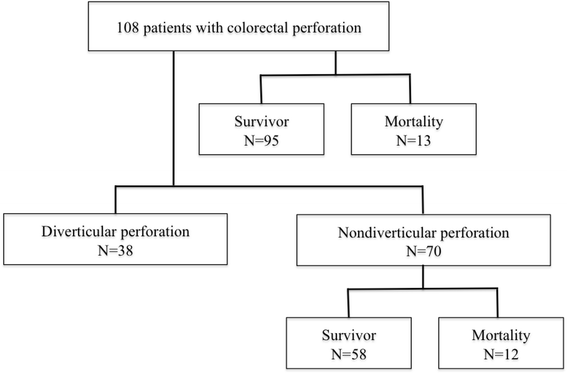
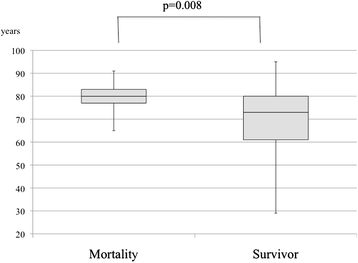
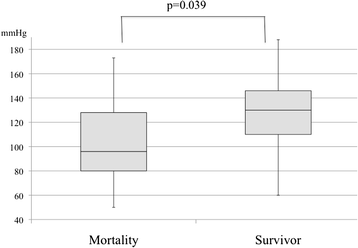
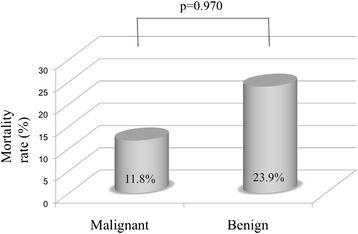
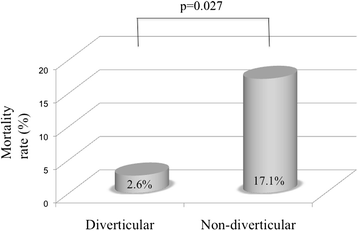
Similar articles
-
Aspects of survival from colorectal cancer in Denmark.Dan Med J. 2012 Apr;59(4):B4428. Dan Med J. 2012. PMID: 22459726
-
Postoperative arterial blood lactate level as a mortality marker in patients with colorectal perforation.Int J Colorectal Dis. 2014 Jan;29(1):51-5. doi: 10.1007/s00384-013-1738-1. Epub 2013 Jul 12. Int J Colorectal Dis. 2014. PMID: 23846515 Free PMC article.
-
Factors affecting the early mortality of patients with nontraumatic colorectal perforation.Surg Today. 2003;33(1):13-7. doi: 10.1007/s005950300002. Surg Today. 2003. PMID: 12560901
-
Multivariate analysis of the prognostic value of CEA and CA 19-9 serum levels in colorectal cancer.Anticancer Res. 2000 Nov-Dec;20(6D):5195-8. Anticancer Res. 2000. PMID: 11326694
-
Risk factors for surgical site infection in emergency colorectal surgery: a retrospective analysis.Surg Infect (Larchmt). 2014 Jun;15(3):256-61. doi: 10.1089/sur.2012.154. Epub 2014 May 8. Surg Infect (Larchmt). 2014. PMID: 24810804
Cited by
-
Combination of dirty mass volume and APACHE II score predicts mortality in patients with colorectal perforation.World J Emerg Surg. 2021 Mar 30;16(1):17. doi: 10.1186/s13017-021-00359-y. World J Emerg Surg. 2021. PMID: 33785047 Free PMC article.
-
Prediction of hospital mortality after colorectal perforation surgery from inflammation-based prognostic scores.Surg Open Sci. 2022 Jan 26;8:40-46. doi: 10.1016/j.sopen.2022.01.003. eCollection 2022 Apr. Surg Open Sci. 2022. PMID: 35280120 Free PMC article.
-
Application of natural orifice transluminal endoscopic surgery with ENDOCRAB system for stomach perforation model: ex vivo porcine study.Sci Rep. 2024 Mar 27;14(1):7289. doi: 10.1038/s41598-024-56484-6. Sci Rep. 2024. PMID: 38538657 Free PMC article.
-
2017 WSES guidelines for the management of iatrogenic colonoscopy perforation.World J Emerg Surg. 2018 Jan 24;13:5. doi: 10.1186/s13017-018-0162-9. eCollection 2018. World J Emerg Surg. 2018. PMID: 29416554 Free PMC article. Review.
-
Factors associated with postoperative recurrence in perforated colorectal cancer: unraveling the high recurrence rate of perforated colorectal cancer.World J Surg Oncol. 2025 Apr 11;23(1):139. doi: 10.1186/s12957-025-03783-5. World J Surg Oncol. 2025. PMID: 40217242 Free PMC article.
References
-
- Alvarez JA, Baldonedo RF, Bear IG, Otero J, Pire G, Alvarez P, et al. Outcome and prognostic factors of morbidity and mortality in perforated sigmoid diverticulitis. Int Surg. 2009;94:240–8. - PubMed
LinkOut - more resources
Full Text Sources
Other Literature Sources

